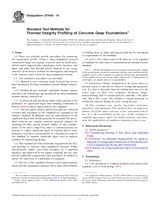Potřebujeme váš souhlas k využití jednotlivých dat, aby se vám mimo jiné mohly ukazovat informace týkající se vašich zájmů. Souhlas udělíte kliknutím na tlačítko „OK“.
ASTM D7949-14
Standard Test Methods for Thermal Integrity Profiling of Concrete Deep Foundations (Withdrawn 2023)
Automaticky přeložený název:
Standardní Zkušební metody pro Thermal Integrity Profilování betonových hlubinných
NORMA vydána dne 1.11.2014
Informace o normě:
Označení normy: ASTM D7949-14
Poznámka: NEPLATNÁ
Datum vydání normy: 1.11.2014
Kód zboží: NS-39298
Počet stran: 7
Přibližná hmotnost: 21 g (0.05 liber)
Země: Americká technická norma
Kategorie: Technické normy ASTM
Kategorie - podobné normy:
Anotace textu normy ASTM D7949-14 :
Keywords:
barrette, bored pile, concrete curing, drilled shaft, heat of hydration, integrity test, thermal testing,, ICS Number Code 91.080.40 (Concrete structures)
Doplňující informace
| Significance and Use | ||||||
|
5.1 Temperature measurements taken from a thermal probe lowered into access ducts in the deep foundation element, or from embedded thermal sensors distributed along the length, can be used to assess the homogeneity and integrity of concrete both inside and outside the reinforcing cage, as well as placement of the cage relative to the center of the curing concrete.Note 4: If flaws are detected, then further evaluation and potential remediation may be warranted to determine if the flaw is a defect. Any interpretation is qualitative and possibly relative to the particular deep foundation element material, construction characteristics of the tested structure, and the apparatus used. Interpretation therefore should contain proper engineering judgment and experience. |
||||||
| 1. Scope | ||||||
|
1.1 These test methods provide procedures for measuring the temperature profile within a deep foundation element constructed using cast-in-place concrete, such as bored piles, drilled shafts, augered piles, diaphragm walls, barrettes, and dams, and alike. The thermal profile induced by the curing concrete can be used to evaluate the homogeneity and integrity of the concrete mass within the deep foundation element. 1.2 Two alternative procedures are provided: 1.2.1 Method A uses a thermal probe lowered into access ducts installed in the deep foundation element during construction. 1.2.2 Method B uses multiple embedded thermal sensors attached to the reinforcing cage installed in the deep foundation element during construction. 1.3 All observed and calculated values shall conform to the guidelines for significant digits and rounding established in Practice D6026, unless superseded by this standard. 1.3.1 The procedures used to specify how data are collected/recorded and calculated in this standard are regarded as the industry standard. In addition, they are representative of the significant digits that should generally be retained. The procedures used do not consider material variation, purpose for obtaining the data, special purpose studies, or any considerations for the user’s objectives; and it is common practice to increase or reduce significant digits of reported data to commensurate with these considerations. It is beyond the scope of this standard to consider significant digits used in analysis methods for engineering design. 1.4 This standard provides minimum requirements for thermal profiling of concrete deep foundation elements. Plans, specifications, and/or provisions prepared by a qualified engineer, and approved by the agency requiring the test, may provide additional requirements and procedures as needed to satisfy the objectives of a particular test program. 1.5 The text of this standard references notes and footnotes, which provide explanatory material. These notes and footnotes (excluding those in tables and figures) shall not be considered as requirements of the standard. 1.6 Units—The values stated in SI units are to be regarded as standard. No other units of measurement are included in this standard. Note 1: ASTM International takes no position respecting the
validity of any patent rights asserted in connection with any item
mentioned in this standard. Users of this standard are expressly
advised that determination of the validity of any such patent
rights, and the risk of infringement of such rights, are entirely
their own responsibility.
1.7 Limitations—Proper installation of the access ducts or thermal sensors is advised for effective testing and interpretation. If a flaw is detected, then the method does not give the exact type of flaw (for example, inclusion, bulge, honeycombing, lack of cement particles, and alike.) but rather only that a flaw exists. The method is limited primarily to testing the concrete during the early curing process. 1.8 This standard may involve hazardous materials, operations, and equipment. This standard does not purport to address all of the safety concerns, if any, associated with its use. It is the responsibility of the user of this standard to establish appropriate safety and health practices and determine the applicability of regulatory limitations prior to use. |
||||||
| 2. Referenced Documents | ||||||
|




 Cookies
Cookies
